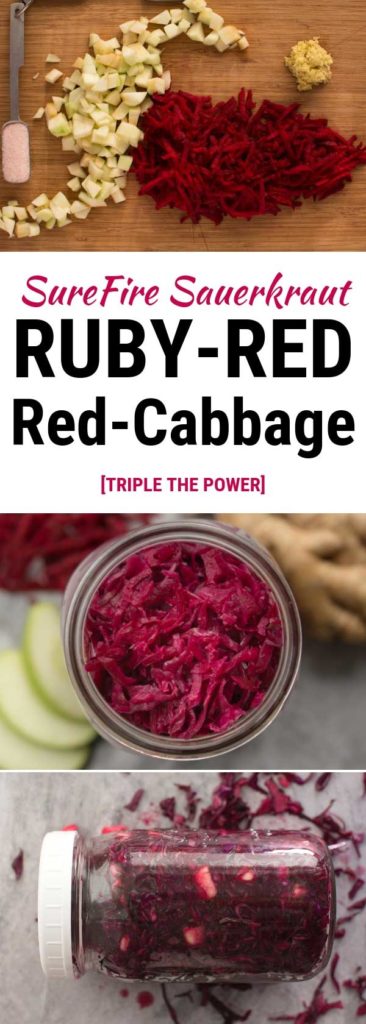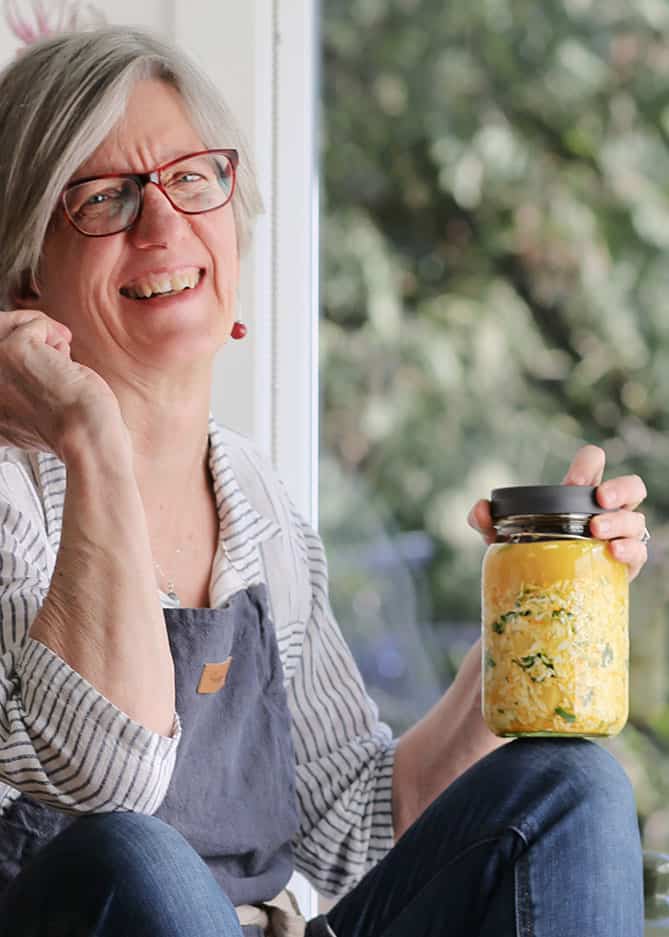There are many nutritional benefits hidden in sauerkraut fermented with red cabbage. Just like in pigment-rich blueberries, the compounds that give red cabbage its distinctive dark color act as antioxidants. Red cabbage has one of the highest levels of naturally available vitamin C, more even than oranges. And of course, this sauerkraut is rich in various strains of beneficial bacteria, especially when you select top-quality cabbage.
Probiotics + antioxidants + vitamin C make this sauerkraut a triple winner.
This recipe also includes beets which are an amazing source of minerals and unique health-boosting nutrients.
These grungy-looking roots are sweet, impart a beautiful ruby-red color to your sauerkraut, and pack tons of flavor underneath their rugged exterior. The plant pigment that gives beets their rich, purple-crimson color is betacyanin; a powerful agent thought to suppress the development of some types of cancer. In addition, they are a wonderful tonic for the liver, working to purify the blood.
Note: If this is your first time making sauerkraut, you may want to read over my teaching recipe: How to Make Sauerkraut In a Jar in 7 Simple Steps [Healthy, Flavorful, Easy], with its step-by-step photography, tips, and additional fermentation information first, then return to this recipe.
Notes and Tips to Get You Started on Ruby-Red Red-Cabbage Sauerkraut
Beets have the Highest Sugar Content of All Vegetables
This is not a bad thing, just be aware that if you add too many beets to your sauerkraut, the sugar content of your ferment is such that it may turn into a sweet slime.
When adding the grated beets to the scale, I keep an eye on the weight and try to keep it under 25% of the total weight for the recipe. For a 1-quart (liter) batch this would be 7 ounces (200 grams). This should prevent the development of a slimy ferment.
Beets can be Tough to Grate
I always peel them first – to get rid of the “dirt” taste – and if I’m making an extra-large batch of sauerkraut, I pull out my food processor. Otherwise, use your hand grater, and glove, if you don’t want a red hand for a day or two.
Remove the red stain from your hands.
If your hands become stained with beetroot, rub them with lemon juice and salt before washing them with soap and water.
Fermenting with Fruit
When I add fruit to a ferment, I shorten the fermentation time. In this recipe, the extra sugar from the apple gives the bacteria extra sugar to consume, and if left to ferment for too long, your ferment can shift toward the alcohol side.
Small “Jelly” Canning Jar
My sauerkraut recipes call for a small 4-ounce (125 ml) “Jelly” canning jar which is used as a weight to hold the fermenting sauerkraut below the brine. For other ideas on what to use as a weight see:
Fermentation Weights: Keep Your Ferment Below the Brine and BEST Fermentation Weight for Fermenting in Jars [28-Day Challenge].
Browning of Your Ferment
You may notice – if conditions aren’t optimal – that the top inch or so of your sauerkraut loses its color and turns a bit brown. This is oxidation and it can occur during fermentation or if stored for too long in your refrigerator.
It is especially prevalent when fermenting with beets or red cabbage. Just scoop off the browned section and enjoy the goodness below. And, try to eat sauerkraut containing beets within 5-6 months of fermentation.
3 Mouthwatering Ways to Enjoy Your Ruby-Red Red-Cabbage Sauerkraut Recipe
1. Straight Out of the Jar
Don’t complicate matters. Just add a forkful or two of Ruby-Red Red-Cabbage Sauekrauat to whatever meal you’re having. Simple!
2. Tossed into a Salad
My lunch generally is one humungous salad that always includes a shot of sauerkraut. Ruby-Red Red-Cabbage Sauerkraut would be nice mixed with lettuce, a fresh apple, and perhaps a few raisins. No need to make a fancy dressing. Just use the brine from what accompanies the sauerkraut, add a glug or two of olive oil, and sprinkle on a pinch of salt.
3. Blended into a Green Smoothie
If you make green smoothies, a few forkfuls of Ruby-Red Red-Cabbage sauerkraut would be a powerful probiotic, antioxidant, and mineral-rich addition.
How to Ferment a Big Batch of Ruby-Red Red-Cabbage Sauerkraut
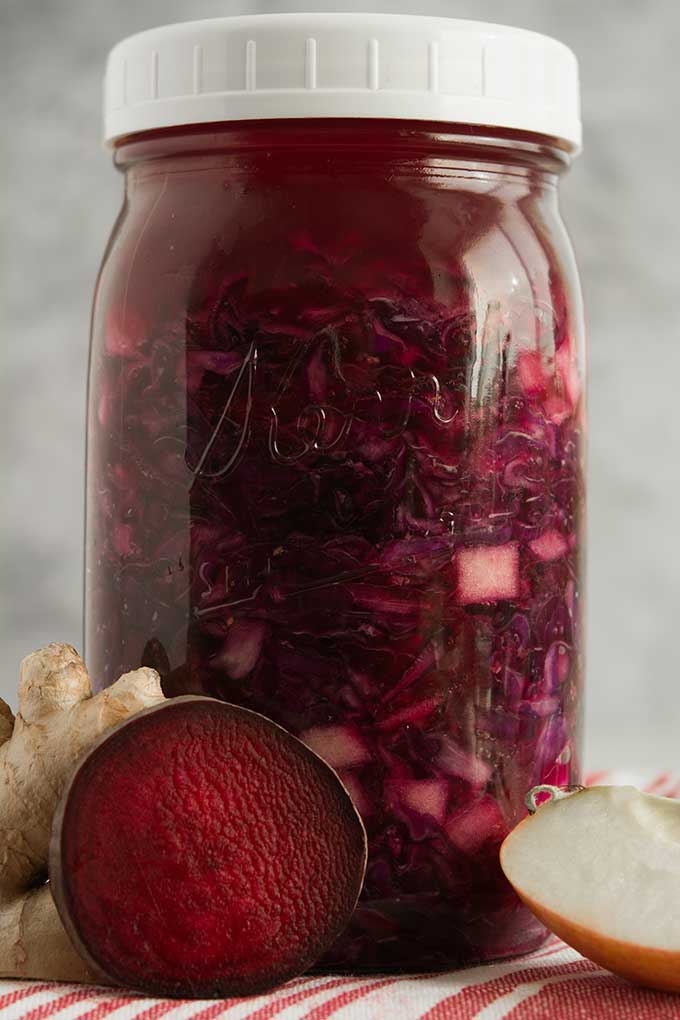
If you find that you love Ruby-Red Red-Cabbage Sauerkraut, it’s easy to make a big batch. Sauerkraut fermented in the large, temperature-stable environment of a water-sealed fermentation crock tends to have not only more brine but also a greater depth of flavor.
Quantities for this sauerkraut recipe can easily be adjusted. It’s best to make – and pack your fermenting crock with – successive 5-pound batches (triple the ingredients of a 1-quart batch) until your crock is about 80% full. Follow How to Make Sauerkraut In a Crock in 7 Simple Steps [Healthy, Flavorful, Easy] for all the tips and tricks to ensure mouthwatering success.
The Five Tools I Grab Every Time I Make a Batch of Sauerkraut
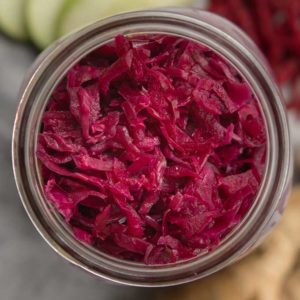
Ruby-Red Red-Cabbage Sauerkraut Recipe
EQUIPMENT
- Kitchen scale, ideally digital
- Cutting board and chef’s knife
- Large mixing bowl
- 1-quart (L) wide-mouth canning jar or similar sized jar
- 4-ounce (125 ml) canning jar (jelly jar)
- Wide-mouth plastic storage cap. You can also use the lid and rim that comes with the jar.
INGREDIENTS
- 1 medium beet, peeled and grated, baseball size
- 1 tart apple, peeled and finely diced
- 1 2-inch (5 cm) piece of fresh ginger root, peeled and finely grated
- 1 medium head fresh red cabbage, 2–3 pounds (1 kg)
- 1 tablespoon (15 ml) iodine-free salt (fine-grain)
INSTRUCTIONS
- SET UP. Gather Supplies and Set Up ScalePlace your bowl on the scale. Either zero out the scale or write down the tare of your bowl.
- CHOP. Prep Your Vegetables and CabbagePrep your beet, apple, and ginger and place in your bowl. Add sliced cabbage to your bowl until the weight of the flavoring ingredients and cabbage is 1¾ pounds (28 oz or 800 g).
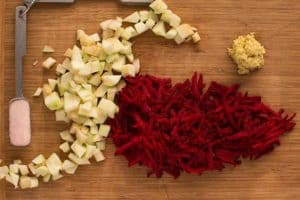
- SALT. Create Your BrineSprinkle with 1 tablespoon salt—that’s 16 grams (or 2%) by weight. Thoroughly mix beets, ginger, apple, and cabbage until salt is well dispersed.Let sit at room temperature for 10-20 minutes to allow the salt to pull the water out of the vegetables. Then massage the cabbage with strong hands until it clumps together and a puddle of brine can be seen when tipping bowl to the side. If you're having trouble getting enough brine, read the tips in my post on dry sauerkraut.
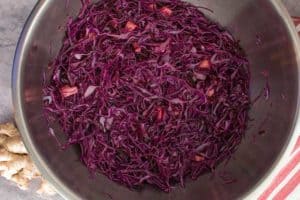
- PACK. Pack Mixture into JarPack mixture into your jar, pressing cabbage down tightly with your fist to allow the brine to rise. Leave 1½–2 inches (4–5 cm) of space between the top of your cabbage and the top of the jar.
- SUBMERGE. Hold Ferment Below BrineTake the cabbage leaf saved in step 2, tear it to just fit inside the jar, and place it on top of the packed mixture. Using your preferred weight to hold the mixture below the brine, screw on lid or airlock lid of choice, following product directions. Label your jar with date and flavor.
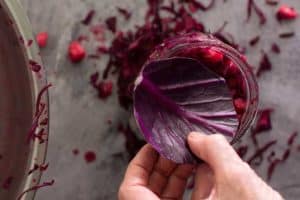
- FERMENT. Ferment for 2 to 4 WeeksPlace in a shallow bowl on your kitchen counter, out of direct sunlight—ideally between 65 and 72 °F (18–22 °C)—to ferment until texture and tang is to your liking.For what to expect while your batch of sauerkraut is fermenting see: SALTY Cabbage to SOUR Sauerkraut: Fermentation Signs to Monitor
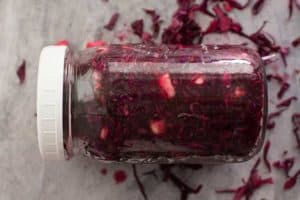
- STORE. Store in Refrigerator for Up to 6 MonthsOpen the jar, remove the weight, and clean rim and jar. Firmly screw on storage lid. Add fermentation time to your label and place in your refrigerator.Enjoy a forkful or two of your sauerkraut with your meals. It will continue to ferment – aging like a fine wine – but at a much slower rate than before. If the flavors are too intense, leave the jar for a month or two and then eat it. You will be amazed at how the flavors have shifted. See 19+ Easy Ways to Eat Sauerkraut for more ideas on how to enjoy your homemade jar of powerful probiotics. If successfully fermented, your sauerkraut can be kept preserved in your refrigerator for up to a year… at least!
Notes and Tips
- Beets have high sugar content. Keep the weight under 25% of the total weight for the recipe to prevent the development of a slimy ferment. For a 1-quart (liter) batch this would be 7 ounces (200 grams).
- Beets can be tough to grate. Peel them first to get rid of the “dirt” taste. If you’re making an extra-large batch of sauerkraut, you may use a food processor. Otherwise, use your hand grater and glove to avoid staining your hands.
- If your hands become stained with beetroot, rub with lemon juice and salt before washing with soap and water.
- Adding fruit to a ferment shortens the fermentation time. In this recipe, the extra sugar from the apple gives the bacteria extra sugar to consume, and if left to ferment for too long, your ferment can shift toward the alcohol side.
- If your sauerkraut loses its color and turns a bit brown, just scoop off the browned section and enjoy the goodness below.
- Try to eat sauerkraut containing beets within 5-6 months of fermentation.
- This sauerkraut recipe calls for a small 4-ounce (125 ml) “Jelly” canning jar which is used as a weight to hold the fermenting sauerkraut below the brine. For other ideas on what to use as a weight, see: Fermentation Weights: Keep Your Ferment Below the Brine and BEST Fermentation Weight for Fermenting in Jars [28-Day Challenge].
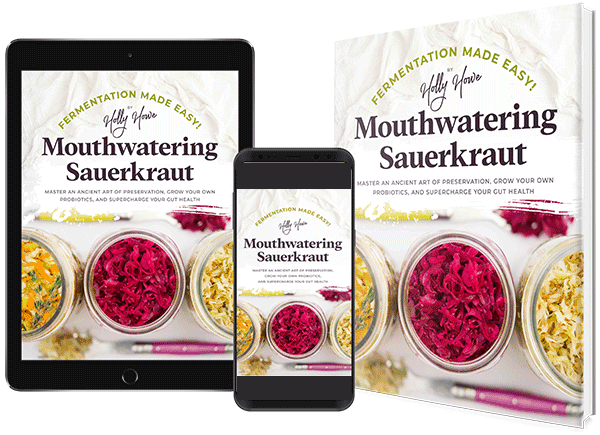
The Book That Takes The Guesswork Out Of Making Sauerkraut
Struggling to make sauerkraut with good flavor and no mold? Discover my 7-step process to ferment delicious sauerkraut that you’re not afraid to eat.
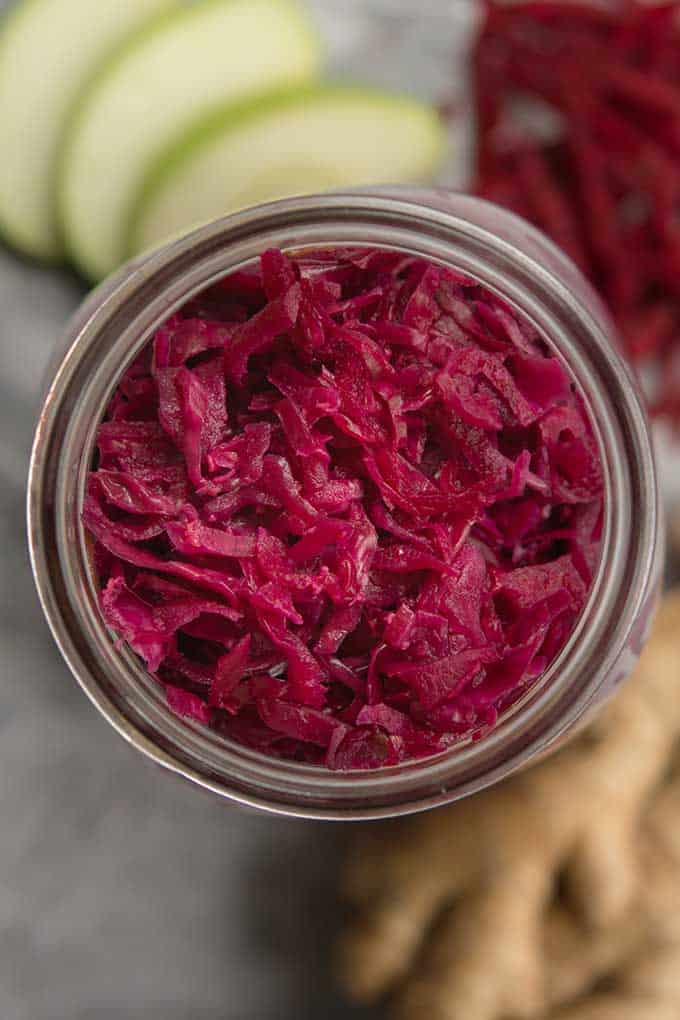
Beets are so concentrated, nutritionally speaking, that many natural vitamins are derived from them. Dr. Bruce West recommends eating a few spoonfuls of beets per day as a sure method of ingesting adequate vitamins and minerals on a regular basis and as a way of detoxifying the body as well. They contain special properties that protect the liver and stimulate the flow of bile. Beets and beet juice have been used successfully in cancer therapies. —Sally Fallon Morell, Nourishing Traditions
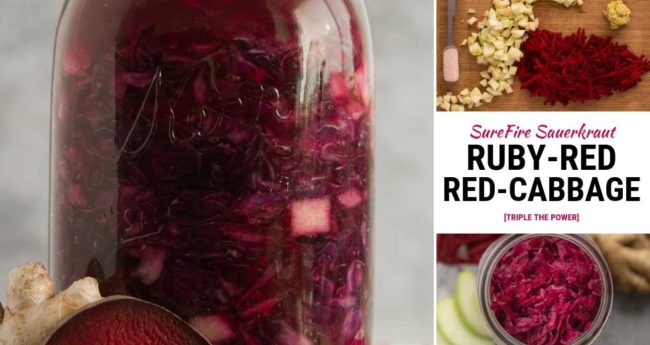
Last update on 2024-07-26 / Affiliate links / Images from Amazon Product Advertising API

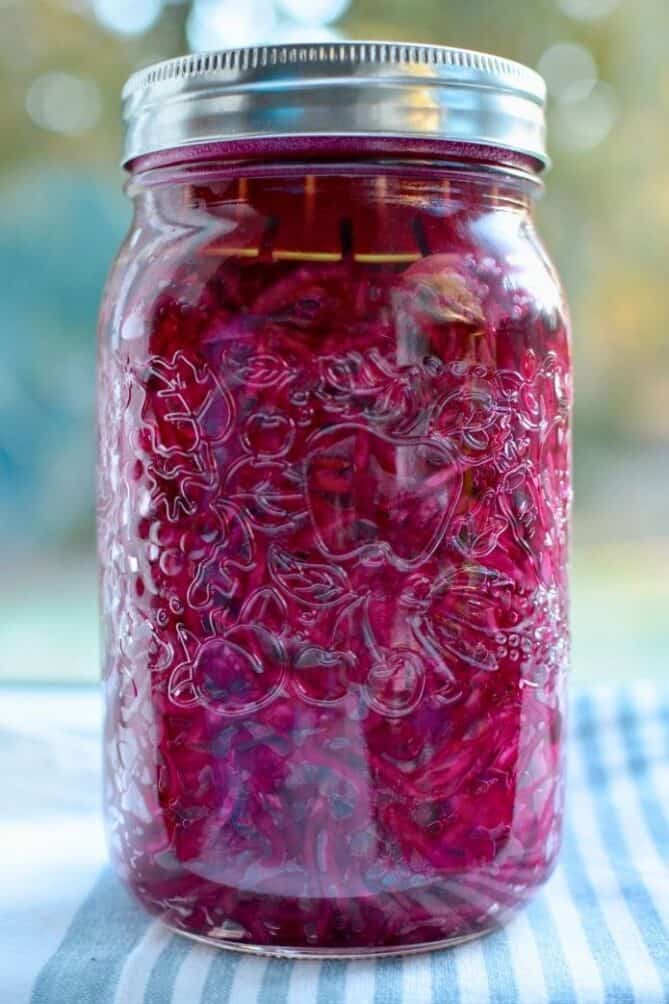

 This post may contain affiliate links which won’t change your price but will share some commission.
This post may contain affiliate links which won’t change your price but will share some commission.